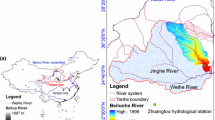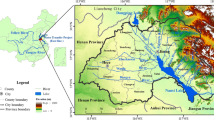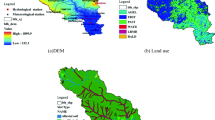Abstract
Chinese Loess Plateau is considered as one of the most serious soil loss regions in the world, its annual sediment output accounts for 90 % of the total sediment loads of the Yellow River, and most of the Loess Plateau has a very typical characteristic of “soil and water flow together”, and water flow in this area performs with a high sand content. Serious soil loss results in nitrogen and phosphorus loss of soil. Special processes of water and soil in the Loess Plateau lead to the loss mechanisms of water, sediment, nitrogen, and phosphorus are different from each other, which are greatly different from other areas of China. In this study, the modified export coefficient method considering the rainfall erosivity factor was proposed to simulate and evaluate non-point source (NPS) nitrogen and phosphorus loss load caused by soil and water loss in the Yanhe River basin of the hilly and gully area, Loess Plateau. The results indicate that (1) compared with the traditional export coefficient method, annual differences of NPS total nitrogen (TN) and total phosphorus (TP) load after considering the rainfall erosivity factor are obvious; it is more in line with the general law of NPS pollution formation in a watershed, and it can reflect the annual variability of NPS pollution more accurately. (2) Under the traditional and modified conditions, annual changes of NPS TN and TP load in four counties (districts) took on the similar trends from 1999 to 2008; the load emission intensity not only is closely related to rainfall intensity but also to the regional distribution of land use and other pollution sources. (3) The output structure, source composition, and contribution rate of NPS pollution load under the modified method are basically the same with the traditional method. The average output structure of TN from land use and rural life is about 66.5 and 17.1 %, the TP is about 53.8 and 32.7 %; the maximum source composition of TN (59 %) is farmland; the maximum source composition of TP (38.1 %) is rural life; the maximum contribution rates of TN and TP in Baota district are 36.26 and 39.26 %, respectively. Results may provide data support for NPS pollution prevention and control in the loess hilly and gully region and also provide scientific reference for the protection of ecological environment of the Loess Plateau in northern Shaanxi.











Similar content being viewed by others
References
Austin AT, Yahdjian L, Stark JM (2004) Water pulses and biogeochemical cycles in arid and semiarid ecosystems. Oecologia 141:221–235
Bian YS (2000) Waste treatment, regeneration and utilization in ecological agriculture. Chemical Industry Press, Beijing, pp 114–200
Bu HM, Meng W, Zhang Y, Wan J (2014) Relationships between land use patterns and water quality in the Taizi River basin, China. Ecol Indic 41:187–197
Cai M, Li HE, Zhuang YT, Wang QH (2004) Application of modified export coefficient method in polluting load estimation of non-point source pollution. J Hydraul Eng 7:40–45
Cheng HG, Yue Y, Yang ST et al (2006) An estimation and evaluation of non-point source (NPS) pollution in the Yellow River Basin. Acta Sci Circumst 26(3):384–391
Ding XW, Liu RM, Shen ZY (2006) Method for obtaining parameters of export coefficient model using hydrology and water quality data and its application. J Beijing Normal Univ (Nat Sci) 42(5):534–538
Fu C, Kang WY (2012) Research on spatial characteristics of TN & TP of agricultural non-point source pollution in the surrounding area of the Poyang lake. Resour Environ Yangtze Basin 21(7):864–868
Garbrecht J, Campbell J (1997) TOPAZ: an automated digital landscape analysis tool for topographic evaluation, drainage identification, watershed segmentation and sub-catchment parameterization. TOPAZ User Manual. USDA-ARS, Oklahoma
Giles J (2005) Nitrogen study fertilizes fears of pollution. Nature 433(2):791
Hart MR, Quin BF, Long Nguyen M (2004) Phosphorus runoff from agricultural land and direct fertilizer effects: a review. J Environ Qual 33:1954–1972
Hu HX, MA YH (2008) Soil and water loss and agricultural non-point source pollution. Chin Agric Sci Bull 24(6):408–412
Huang YG, Fu LL, Hu XM (2012) Study and application of export coefficient model of non-point source pollution load using in-situ data. J Hydroelectric Eng 31(5):159–162
Jia HY, Peng L, Peng XL et al (1994) Partition and evaluation of soil nutrient resources in the Loess Plateau. J Soil Water Conserv 8(3):22–28
Jiao JY, Wang WZ, Hao XP (1999) Precipitation and erosion characteristics of different types of rainfall in the Loess Plateau. J Arid Land Resour Environ 13(1):34–42
Johnes PJ (1996) Evaluation and management of the impact of land use change on the nitrogen and phosphorus load delivered to surface waters: the export coefficient modelling approach. J Hydrol 183:323–349
Kang XY (2010) The evaluation and prediction of non-point source pollution in Poyang Lake Area. Dissertation of master degree. Nanchang University, Nanchang
Ke M, Ao TQ, Zhou L, et al. (2014) Non-point Source Evaluation of Xi-chong River Basin in Xi-chong County Based on Output Coefficient Model.(3): 20–24
Kite GW (2001) Modelling the Mekong: hydrological simulation for environmental impact studies. J Hydrol 253:1–13
Kite GW (2002) Manual for the SLURP Hydrological Model Version 12.2. NHRI Publ, Canada
Lacroix MP, Martz LW, Kite GW, Garbrecht J (2002) Using digital terrain analysis modeling techniques for the parameterization of a hydrologic model. Environ Model Softw 17:127–136
Li G, Mao F (2008) Evaluation on non-point source pollution of soil and water loss and its economic loss of China. Soil Water Conserv China 2:9–11
Li HE, Wang L, Shi SJ (2010a) Estimation of total nitrogen load from non-point sources in Shaanxi Province water source area of the central line of South–North Water Diversion Project. J Northwest Univ (Nat Sci Ed) 40(3):540–544
Li HE, Zhuang YT (2003) The export coefficient modeling approach for load prediction of nutrient from nonpoint source and its application. J Xi an Univ Technol 19(4):307–312
Li HP, Huang WY, Yang GS, Li ZF (2006a) Non-point source pollutant concentration in typical towns of Taihu Upriver Region. J Agro-Environ Sci 25(6):1598–1602
Li HP, Huang WY, Yang GS, Liu XM (2006b) Non-point pollutant concentrations for different land uses in Lihe River watershed of Taihu Region. China Environ Sci 26(2):243–247
Li HP, Liu XM, Huang WY (2004a) The non-point output of different landuse types in Zhexi hydraulic region of Taihu Basin. Acta Geograph Sin 59(3):401–408
Li JK (2009) Research on non-point source pollution load quantification for watershed-taking the weihe river basin as an example. Doctoral dissertation, Xian: Xi'an University of Technology
Li QK, Li HE (2010) The preliminary frame of non point source pollution study in the Yellow River watershed. Yellow River 32(12):131–135
Li QZ, Wang DY, Zhu B (2004b) The output rule of non-point source phosphorus Load in purple soil under natural rainfall. J Agro-Environ Sci 23(6):1050–1052
Li R, Li BC, Yang WZ et al (2008) Research and prospect of the Loess Plateau in China. Science Press, Beijing
Li Z, Zheng FL, Liu WZ (2010b) Analyzing the spatial-temporal changes of extreme precipitation events in the Loess Plateau from 1961 to 2007. J Nat Resour 25(2):291–299
Li ZF, Yang GS, Li HP (2007) Estimation of nutrient export coefficient from different land use types in Xitiaoxi watershed. J Soil Water Conserv 21(1):30–90
Li ZF, Yang GS, Li HP (2009) Estimated nutrient export loads based on improved export coefficient model in Xitiaoxi watershed. Environ Sci 30(3):668–672
Liang T, Wang HP, Zhang XM (2005) Simulation study of non-point source pollution under different land use in Guanting Reservoir watershed. Acta Sci Circumst 25(4):483–490
Liao YS, Zhuo MN, Li DQ et al (2014) Estimation of agricultural non-point source nitrogen and phosphorus load based on rainfall-runoff and landuse types. Acta Sci Circumst 34(8):2126–2132
Linsley RK, Kohler MA, Paulhus JHL (1975) Hydrology for Engineers, Second ed. McGraw-Hill
Liu BZ, Li GL, Wu FQ et al (1995) Regulation of soil nutrients loss in Southern Loess Plateau. J Soil Water Conserv 9(2):77–86
Liu P, Wu ZF, Kuang YQ, Wang JC, Cheng J, Chen HX (2005) Preliminary analysis of rainfall erosivity in Guangdong province based on daily rainfall data. J Trop Meteorol 05:555–560
Liu RM, He MC, Wang XJ (2009) Risk assessment of nitrogen and phosphorus export in upper reach of Daliao River Watershed. Environ Sci 30(3):663–667
Liu RM, Shen ZY, Ding XW, Wu X, Liu F (2008) Application of export coefficient model in simulating pollution load of non-point source in upper reach of Yangtze River Basin. J Agro-Environ Sci 27(2):677–682
Liu YQ, Yang YL, Li FH (2011) Estimation of pollution loads from agricultural nonpoint sources in Beijing region based on export coefficient modeling approach. Trans CSAE 27(7):7–12
Long TY, Liang CD, Li JC et al (2008) Forecasting the pollution load of non-point sources imported to the Three Gorges Reservoir. Acta Sci Circumst 28(3):574–581
Lu JZ, Chen XL, Xiao JJ et al (2012) Application of an improved export coefficient method in estimation of agricultural pollution source. J Huazhong Normal Unv (Nat Sci) 46(3):373–378
Ma GW, Wang YY, Xiang B, Wang JS, Hu Y (2012) Diversity and effect of diffuse pollution load caused by land use change in the upper reach of Yangtze River Basin, China. J Agro-Environ Sci 31(4):791–797
Mao F, Su KZ, Kang JT et al (2012) Research on heavy metal load accounting in mining areas using improved export coefficient method. Res Environ Sci 25(2):207–211
Nandish MM, Keith SR (1996) Estimation of surface water quality changes in response to land use change: application of the export coefficient model using remote sensing and geographical information system. J Environ Manag 48:263–282
Ongley ED, Zhang X, Yu T (2010) Current status of agricultural and rural nonpoint source pollution assessment in China. Environ Pollut 158(5):1159–1168
Reckhow KH, Simpson JJ (1980) A procedure using modeling and error analysis for prediction of lake phosphorus concentration from landuse information. Can J Fish Aquat Sci 37:1439–1448
Ren ME (2006) Sediment discharge of the Yellow River, China: past, present and future-A synthesis. Adv Earth Sci 21(6):552–553
Shi H (1997) Non point source pollution of soil and water loss type. Bull Soil Water Conserv 17(7):99–101
Sun B, Zhang LX, Yang LZ et al (2012) Agricultural non-point source pollution in China: causes and mitigation measures. AMBIO 41:370–379
Tian T, Liu RM, Wang XJ et al (2011) Risk assessment of nitrogen and phosphorus export in Daning River of Three Gorges Reservoir Area. Environ Sci Technol 34(6):185–190
Wang DL (2004) Studies on Runoff and Its Water Quality in the Forestry Watershed of Huoditang in Qingling Mountain. Master degree thesis, Yang Ling: Northwest A&F University, 30–33
Wang QJ (2010) Soil solute transfer characteristics with surface runoff and mathematical model of loess slope. Science Press, Beijing
Wickham JD, Riitters KH, O′Neill RV et al (2000) Land cover as a framework for assessing risk of water pollution. J Am Water Resour Assoc 36(6):1417–1422
Wickham JD, Wade TG (2002) Watershed level risk assessment of nitrogen and phosphorus export. Comput Electron Agric 37(1–3):15–24
Worrall F, Burt TP (1999) The impact of land-use change on water quality at the catchment scale: the use of export coefficient and structural models. J Hydrol 221:75–90
Wu L, Long TY, Li CM (2010) The simulation research of dissolved nitrogen and phosphorus non-point source pollution in Xiao-Jiang Watershed of Three Gorges reservoir area. Water Sci Technol 61(6):1601–1616
Wu L, Long TY, Liu X et al (2012) Impacts of climate and land-use changes on the migration of non-point source nitrogen and phosphorus during rainfall-runoff in the Jialing River Watershed, China. J Hydrol 475:26–41
Xu JX (1999) Physico-geographical factors for the formation of hyperconcentrated flows in the Loess Plateau of China. Acta Geograph Sin 54(4):318–326
Yang LZ, Xue LH (2009) Research advances of export coefficient model for non-point source pollution. Chin J Ecol 28(4):755–761
Ying LL, Hou XY, Lu X, Zhu MM (2010) Discussion on the export coefficient method in non-point source pollution studies in China. J Water Resour Water Eng 21(6):11–30
Zhang LK, Xiang B, Hu Y et al (2014) Risk assessment of non-point source pollution in Hulan River Basin using an output coefficient model. J Agro-Environ Sci 33(1):148–154
Zhang SG, Zhang XH, Wang YL (2004) Reflections on non point source pollution control problem in the Yellow River. Soil Water Conserv China 8:11–12
Zhang WB, Xie Y, Liu BY (2002) Rainfall erosivity estimation using daily rainfall amounts. Sci Geogr Sin 22(6):705–711
Zhang WB, Xie Y, Liu BY (2003) Spatial distribution of rainfall erosivity in China. J Mt Sci 1:33–40
Zhao GJ, Tian P, Mu XM et al (2012) Estimation of nitrogen and phosphorus loads in the Xitiaoxi catchment using PCRaster software. Adv Water Sci 23(1):80–86
Zhao W, Xu H, Xie C (2008) Estimation of rainfall erosivity in the Yanhe watershed of the loess hilly-gully area. Trans CSAE 24(Supp.1):38–42
Zhou YL, Wang HJ, Yu H et al (2014) Estimation of nutrient export loads in Taihu Lake watershed based on the export coefficient model. Acta Agric Univ Jiangxiensis 36(3):678–683
Acknowledgments
This study was supported by the open foundation of State Key Laboratory, Institute of Water and Soil Conservation, Chinese Academy of Sciences and Ministry of Water Resources (K318009902-1417), the National Natural Science Foundation of China (51309194), the Doctoral Fund of Ministry of Education of China (20130204120034), 2014 “College Students’ innovation and entrepreneurship training plan” innovation training project, the Initial Scientific Research Funds for PhD from Northwest A&F University (2012BSJJ004), the Fundamental Research Funds for the Central Universities (QN2013047), and the National Natural Science Foundation of China (41371276).
Author information
Authors and Affiliations
Corresponding authors
Additional information
Responsible editor: Zhihong Xu
Rights and permissions
About this article
Cite this article
Wu, L., Gao, Je., Ma, Xy. et al. Application of modified export coefficient method on the load estimation of non-point source nitrogen and phosphorus pollution of soil and water loss in semiarid regions. Environ Sci Pollut Res 22, 10647–10660 (2015). https://doi.org/10.1007/s11356-015-4242-z
Received:
Accepted:
Published:
Issue Date:
DOI: https://doi.org/10.1007/s11356-015-4242-z




